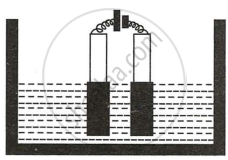Advertisements
Advertisements
प्रश्न
Copper sulphate solution is electrolyzed using copper electrodes. Study the diagram given alongside and answer the questions that follow.

- Which electrode to your left or right is known as the oxidizing electrode and why?
- Write the equation representing the reaction that occurs.
- State two appropriate observations for the above electrolysis reactions.
उत्तर
- The electrode on the left (anode) side donates electrons and hence is the oxidizing electrode.
- \[\ce{Cu - 2e- -> Cu^{2+}}\]
- The anode size steadily lowers while the cathode size gradually increases. However, the colour of the copper sulphate solution does not change.
APPEARS IN
संबंधित प्रश्न
State the observations at the anode and at the cathode during the electrolysis of fused lead bromide using graphite electrodes
The electrolysis of acidified water is an example of :
(A) Reduction
(B) Oxidation
(C) Redox reaction
(D) Synthesis
Molten lead bromide conducts electricity. It is called an ______. It is composed of lead ______ and bromide ______. The lead ions are ______ charged and are called ______. The bromide ______ are ______ charged and are called ______.
Define the following term:
Weak electrolytes
Name a base which is a weak electrolyte.
Name a non-metallic element which is a conductor of electricity.
Explain the following:
Hydrochloric acid is a good conductor of electricity.
Give appropriate scientific reasons for the following statement :
Zinc oxide can be reduced to zinc by using carbon monoxide, but aluminium oxide cannot be reduced by a reducing agent.
Select the ion, that would get selectively discharge from the aqueous mixture of the ions listed below :
\[\ce{SO^{2-}_{4}}\], \[\ce{NO^{-}_{3}}\], \[\ce{OH-}\]
What is the difference between:
Strong electrolyte and weak electrolyte.
